What French and Kuban grape varieties are used to make cognac
This cognac is produced exclusively in France in the Charente region. French law regulates the boundaries of the area of its manufacture. In other countries, any brandy is called cognac - a wine distillate aged in oak barrels with a strength of at least 40 °. Cognac has a characteristic taste, color and aroma. For its production, white table grapes with high acidity and low sugar content are used. What grape varieties are used to make cognac, read on.
The content of the article
Grape varieties for cognac
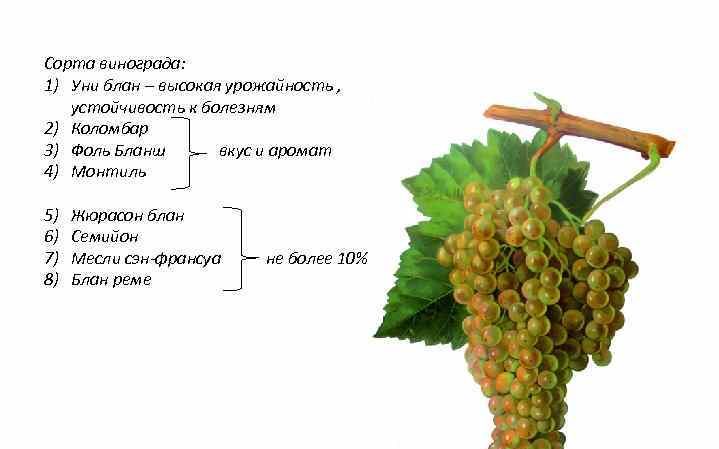
Not all grape varieties are suitable for the production of cognac. For this purpose, white table grapes with white or pink berries are used, which have a harmonious taste without the taste of nutmeg. The taste and aroma of the drink is influenced not only by aging in oak barrels, but also by the complex distillation process, the interaction of aromatic particles with air.
The characteristic taste is formed during production, however, the raw material must be free of foreign tastes and aromas. For example, isabelle varieties are not used for the production of cognac. The pulp of such grapes has a slimy structure. For the ridge, the yield is important, but it is impossible to get it from such a wort.
It is not always possible to obtain a worthwhile cognac from high quality table wines with a refined aroma and rich taste. Burgundy grape varieties give excellent wines with exquisite aroma, but the cognac based on them is devoid of a bright smell and has a weak aftertaste. Very mediocre wines are made from Alyi Tersky and Folle Blanche varieties, and cognac acquires a delicate taste and aroma.
Which grapes are best for cognac? The varieties for the production of the drink are selected by trial and error. Experts have developed specific requirements for raw materials. The variety, sugar content, acidity, cultivation conditions, harvest time, climate are taken into account.

Cognac grapes grow best on rocky, limestone and clay-limestone soils. When grown on wet soils, it acquires the best organoleptic properties. The lack of moisture prevents the berries from accumulating the necessary aromatic substances.
The grapes must be fully ripe. This is facilitated by the conditions of the climatic zone, a sufficient number of sunny days and temperature. The most favorable conditions for growing cognac grape varieties - in the Kuban and France.
Reference. The name of the drink is associated with the surroundings of the Charente region and directly with the town of Cognac, where it appeared. In 1891, the name was enshrined at the legislative level.
In France
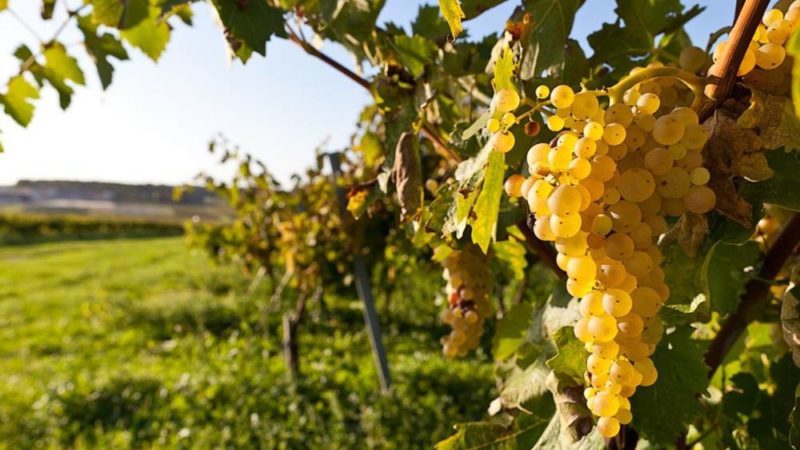
It is generally accepted that the best vineyards are located in France. In the 17th century, winemakers followed the technology of cognac production and achieved outstanding results. At that time, cognac houses appeared, specializing in the production of this drink. One of the first was the Ogier company, which continues to exist today. Its products are very popular in Europe.
In the 18th century, the technology for the production of cognac was improved, thanks to which cognac companies began to massively open. Richard Hennessy, of Irish descent, founded the famous Hennessy house in France. With its appearance, cognac won fame all over the world, and the company's products are considered the standard of quality.
Among the most suitable French varieties for making cognac are Uny-blanc, Colombard, Folle-blanche, Semillon. The agricultural technology of these varieties is complex, so alcohol is expensive. The drinks are characterized by a bright taste and delicate aroma.
Uny-blanc
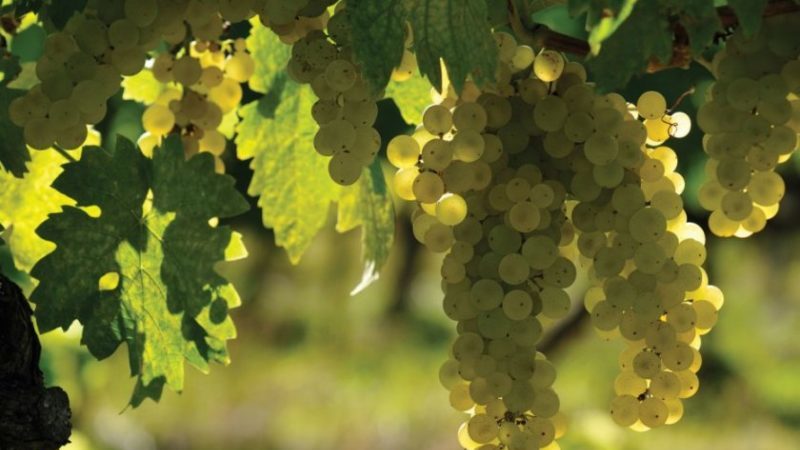
Other variety names: Trebbiano, Uni Blanc, Saint-Emilion. It is a white technical grape, one of the most common in the world. In addition to France, it grows in Australia, New Zealand, Italy. The crop is characterized by productivity and is used to make cognac.
Specifications:
- medium-sized bush;
- medium-sized three- and five-lobed leaves;
- open petiole lyre-shaped notch with an elliptical lumen;
- bisexual flowers;
- clusters are medium in size, conical in shape, dense to medium dense;
- high drought resistance, medium resistance to disease;
- the berries are round, medium in size;
- the skin is white, thick, covered with veins and dots;
- the pulp is juicy, fleshy;
- yield - 90-110 c / ha.
Unyi blanc is ideal for distillation. Manufacturers note its high acidity and low sugar content. A small amount of sugar makes it possible to make a base wine from raw materials with a low percentage of alcohol and to carry out long distillation to achieve the required strength of 72 °. The longer the process lasts, the cleaner the drink.
The increased acidity prevents spoilage of raw materials and wine. This eliminates the need to use sulfur dioxide, which is prohibited in the production of cognac. Distillation with dioxide turns the wine into a slurry with the smell of rotten eggs and boiled cabbage.
Important! Uni Blanc is the main grape variety for the production of cognac.
Colombard
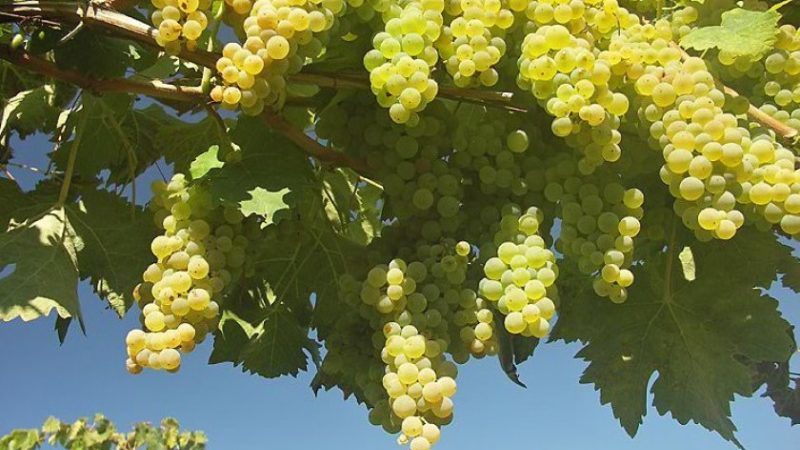
Colombard is a technical white grape variety, a descendant of the Gua and Chenin varieties, the "brother" of the Balzac-blanc cognac grape. In warm regions, Colombard provides raw materials for the production of cognac and wines with good acidity, fresh fruit-floral and floral aromas.
In addition to France, the variety is cultivated in Australia, South Africa, USA (California, Texas).
Specifications:
- medium-sized bush;
- leaves of medium size, rounded;
- flowers are bisexual;
- clusters of medium size, cylindrical conical, medium density;
- berries of medium size, rounded;
- the skin is dense, white with a green tint;
- the pulp is juicy;
- resistance to mildew and gray rot;
- sensitivity to frost;
- yield - 9-13 t / ha.
Fol Blanche
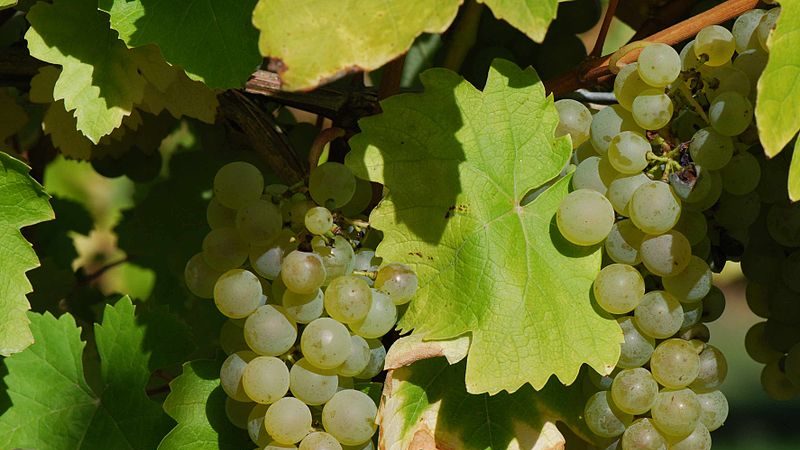
Folle Blanche (Pikul) - a white technical grape for ridge production - is grown exclusively in the west of France. The number of landings is rapidly decreasing.
Specifications:
- increased susceptibility to disease and decay;
- yield - 100-130 c / ha;
- medium-sized bush;
- leaves of medium size, rounded, five-lobed, slightly or moderately dissected, covered with a soft edging;
- bisexual flowers;
- clusters are dense, conical, with pronounced wings;
- rounded berries, medium size;
- the skin is thick, green-yellow, with a waxy coating;
- frost resistance is high.
Semillon
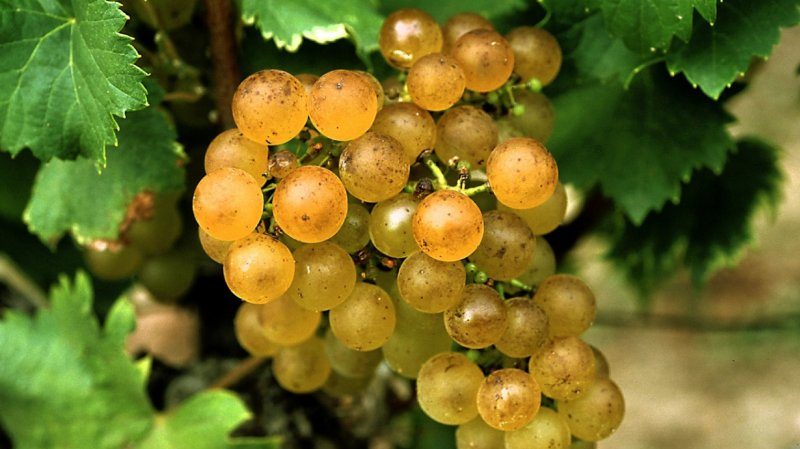
Semillon (Semillon) is a technical white grape variety. It grows in the Bordeaux region, on the banks of the Dordogne River.
Specifications:
- sets late, but ripens early;
- medium-sized bush;
- leaves of medium size, wrinkled, funnel-shaped, five-lobed, the back side is covered with an edge;
- flowers are bisexual;
- petiole lyre-shaped;
- berries of medium size, round shape;
- the skin is thin, golden yellow, with a waxy coating, covered with small brown dots;
- the pulp is juicy, melting;
- medium resistance to mildew, powdery mildew, gray rot;
- weak frost resistance;
- yield - 90-100 c / ha.
Cognac grapes are grown in the vicinity of the city of Cognac. Nature has created favorable conditions for the cultivation of quality material: soil rich in chalk, a temperate climate and sufficient rainfall. The bushes are planted with an interval of 3-4 m. This planting facilitates the mechanical picking of berries. The territory is divided into 6 zones.
An expensive drink with an exquisite taste and aroma is obtained from raw materials collected from the Petite Champagne and Grande Champagne area. In more distant areas, lower quality raw materials are obtained, therefore, cognac spirits are less aromatic and too volatile, and the smell decreases with aging.
Reference. Cognac spirit has the right to be called cognac, provided that it is aged in oak barrels for at least 2 years. There is no maximum drink age.
In the Kuban
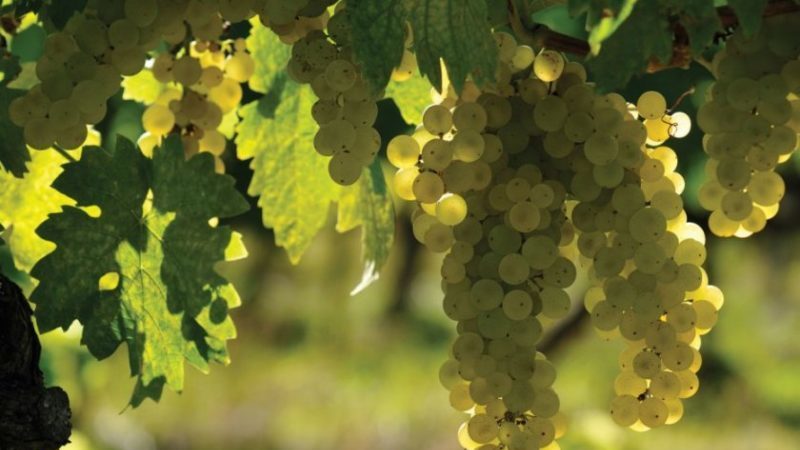
At the beginning of the XXI century, the "Institute of Wine and Viticulture named. Ya. I. Potapenko ”conducted research on popular grape varieties to select the most suitable plants for ridge production. Among the recommended varieties for the Kuban were: Rkatsiteli, Aligote, Scarlet Tersky, Cleret, Sylvaner, Swim.
Rkatsiteli
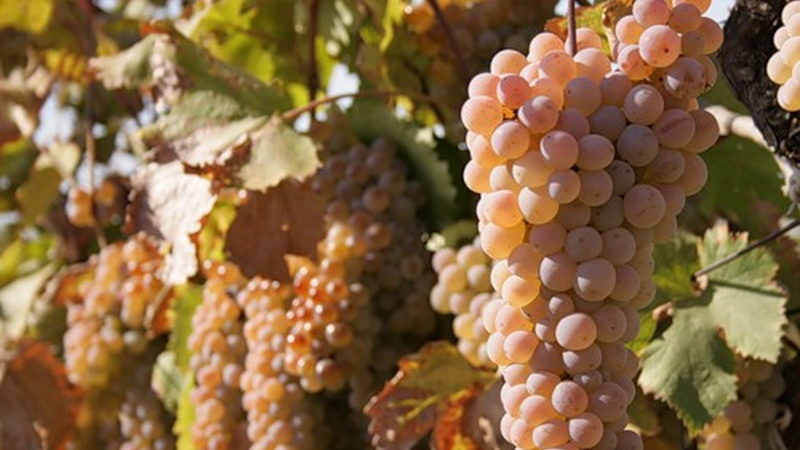
Rkatsiteli is a Georgian grape variety for the production of wines and cognac, port and Madeira.
Specifications:
- complete ripening of the vine;
- average strength of growth;
- yield - 20 t / ha;
- medium resistance to mildew, phylloxera, low to powdery mildew, grape leafworm, spider mite;
- high frost and drought resistance;
- annual shoots are red-yellow;
- medium-sized bush;
- leaves of medium size, medium dissected, whole, weakly funnel-shaped, reticulate-wrinkled, covered with a weak edge on the back;
- petiole notch open, deep, lyre-shaped;
- flowers are bisexual;
- clusters are medium and large, cylindrical-conical, winged, medium-dense;
- berries of medium size, oval;
- the skin is thin, golden yellow with brown spots;
- the pulp is juicy.
Aligote
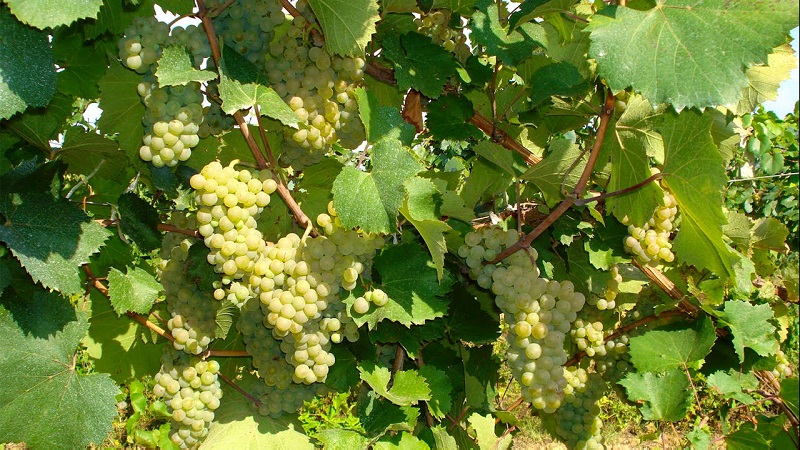
Aligote is a French wine variety for the production of high quality table wine, port and cognac. Has a pronounced varietal taste and flavor.
Specifications:
- low resistance to drought;
- yield - 30 t / ha;
- medium resistance to fungal diseases;
- medium-sized bush;
- leaves are dissected, three-lobed, whole, the edges are bent down, the back side is covered with a light cobweb edge;
- petiole notch vaulted, open;
- flowers are bisexual;
- clusters of medium size, cylindrical, dense;
- berries of medium size, round shape;
- the skin is thin, greenish-white, turns yellow as it ripens;
- the pulp is juicy.
Scarlet Tersky

Scarlet Tersky is a technical grape variety for the production of table wine and brandy. The wines made from it are colored scarlet, characterized by a mediocre taste and aroma. High-quality alcohol and vodka called "Kizlyarki" are obtained from raw materials.
Specifications:
- complete maturation of the vine;
- high strength of growth;
- medium-sized bush;
- yield - 15-18 t / ha;
- medium resistance to powdery mildew, low to mildew;
- frost resistance high;
- leaves deeply dissected, five-lobed, large-bubbly, funnel-shaped, with a dense edging on the back side;
- petiole notch, closed or open;
- flowers are bisexual;
- clusters are large, broadly conical, branched, loose;
- berries of medium size, round or oval;
- the skin is thin, dark blue;
- the pulp is juicy.
Clerette
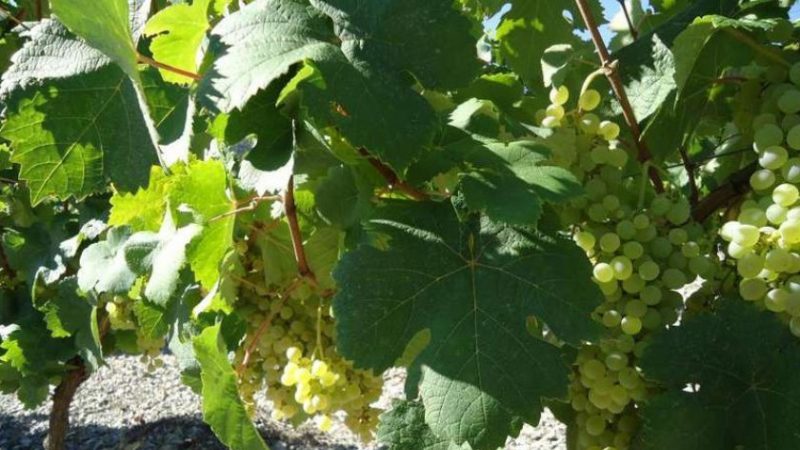
Clerette is a table grape for making wine, ridge and champagne.
Specifications:
- complete ripening of the vine;
- high level of transportability;
- average strength of growth;
- yield - 9-10 t / ha;
- medium-sized bush;
- clusters of medium size, cylindrical;
- high resistance to powdery mildew, low to mildew;
- medium resistance to frost and drought;
- leaves of medium size, dark green, on the back side covered with a dense, tomentose edge, five-lobed, moderately funnel-shaped, curved, slightly wavy;
- petiole notch closed or partially open;
- flowers are bisexual;
- clusters of medium size, broadly conical, lobed, loose;
- berries of medium size, oval;
- the skin is thin, greenish-white with a golden tint;
- the pulp is juicy.
Sylvaner
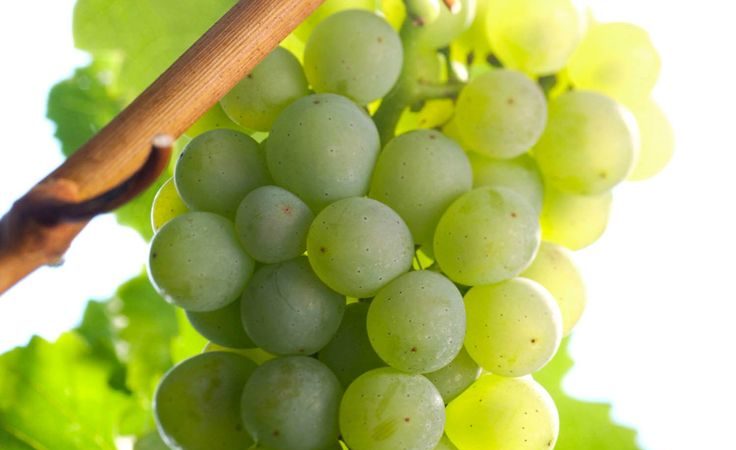
Sylvaner is a technical grape variety native to Austria.Used for the manufacture of cognac, vintage table wines.
Specifications:
- complete ripening of the vine;
- average strength of growth;
- yield - 10 t / ha;
- medium resistance to mildew, low to powdery mildew and grape leafworm;
- high frost resistance;
- drought resistance medium;
- medium-sized bush;
- leaves of medium size, medium dissected, three-lobed, strongly curved, wavy, the outlines of the lobes are rounded, on the back side there is a dense, bristly edge;
- petiole notch open, less often closed, lyre-shaped;
- flowers are bisexual;
- clusters of medium size, cylindrical-conical, lobed, dense;
- berries of medium size, round shape;
- the skin is thin, greenish-white, with large brown spots;
- the pulp is juicy.
Swim
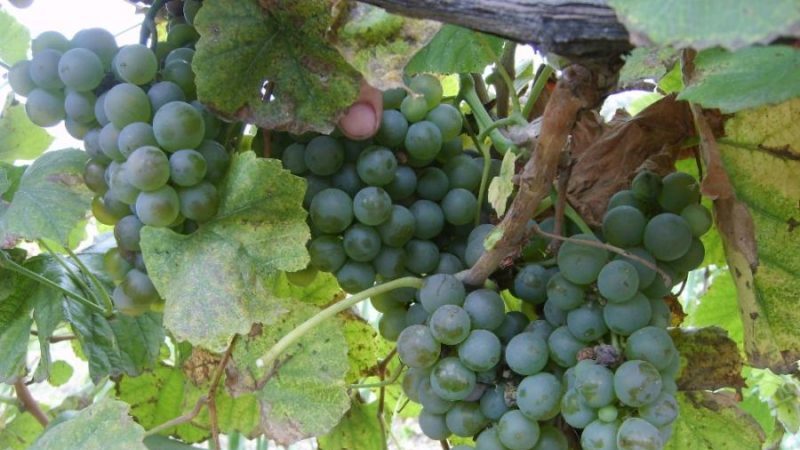
Moldavian technical grade. Distributed in the Kuban, used for the production of table wines, cognac and port.
Specifications:
- yield - 20 t / ha;
- low resistance to mildew and leafworm, medium to phylloxera;
- frost resistance below average;
- medium-sized bush;
- leaves are rounded, slightly dissected, on the back side covered with a dense edging;
- petiole notch more often open, less often closed, lyre-shaped;
- flowers are bisexual;
- clusters of medium size, cylindrical and cylindrical-conical, dense;
- berries of medium size, rounded;
- the skin is thin, transparent, often bursts, green-white in color;
- the pulp is watery.
It is interesting:
Characteristics of ripe berries
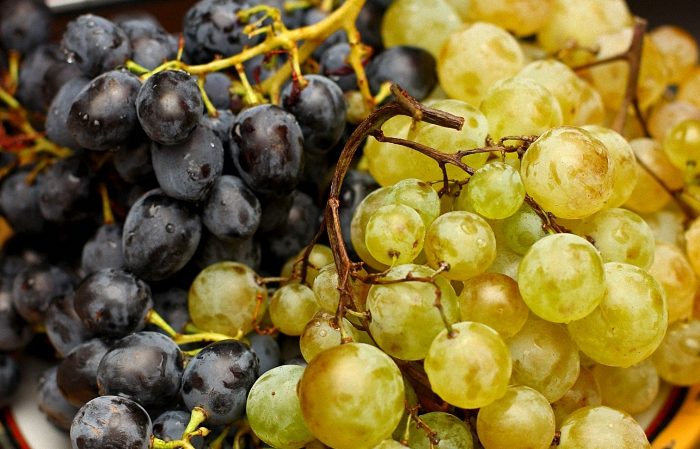
Experts have found that it is possible to obtain high quality raw materials from these varieties, and the cognac has a soft, harmonious, rich taste and aroma.
When harvesting, it is recommended to take into account the ripeness of the grapes. Sugar content should be at the level of 16-18%, acidity - within 7-9 g / l. Berries should not be overripe, since a large amount of sugar is concentrated in them, and the acid content decreases.
The readiness of berries for collection is determined by the following criteria:
- pink or yellow color;
- soft and sticky pulp when crushed;
- thinned skin;
- lignification and brown color of the bunch crest;
- dense dark seeds are easy to extract.
External signs are still considered subjective. To determine the ripeness of berries, the method of chemical analysis is used.
Reference. Cognac barrels are made by hand from 80 years old oak that grows in the forests of Limousin and Tronse. Their volume is 270-450 liters. The Tronsey oak is distinguished by its coarse-grained, low-tannic structure, the Limousin oak - medium-grained and high-tannic. Barrels are fired from the inside, softening the wood structure and increasing its extractive properties.
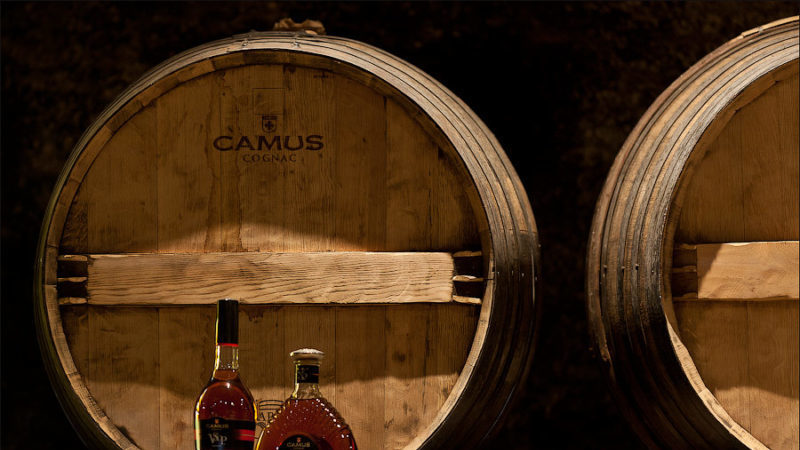
Conclusion
Not all grape varieties are suitable for the production of cognac. In this matter, low sugar content and high acidity are important. The characteristic taste appears during the manufacturing process, and the wine material should be free of foreign tastes and odors. The grapes should be fully ripe, but not overripe.
The most favorable conditions for the cultivation of cognac grape varieties are in the Kuban and in France. The following varieties are recommended for the Kuban: Rkatsiteli, Aligote, Aly Tersky, Cleret, Silvaner, Plavai. In France, Uny-blanc, Colombard, Folle-blanche, Semillon are cultivated.